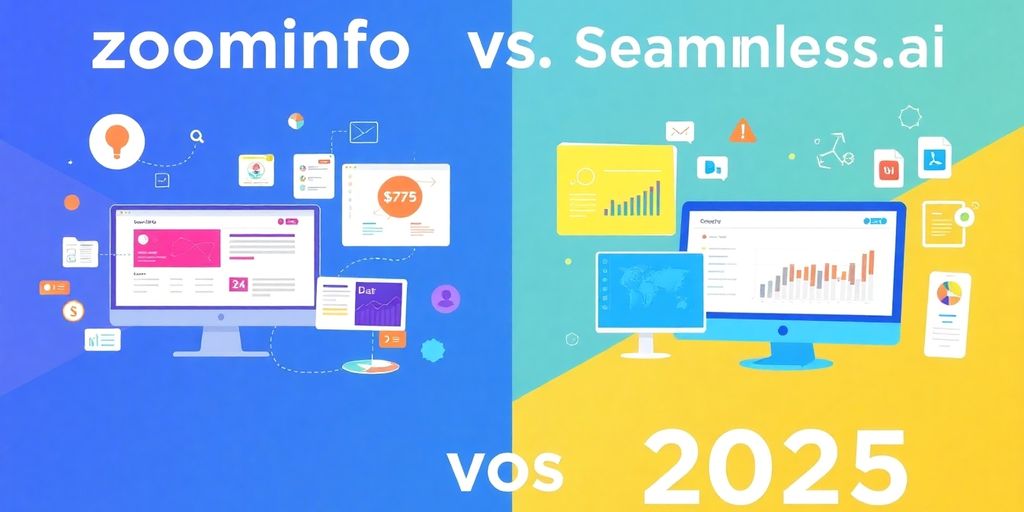Last updated on May 26th, 2025 at 06:57 am
In today’s fast-paced educational environment, students are constantly seeking ways to improve their productivity and learning experiences. AI tools have become essential in this quest, offering innovative solutions to everyday academic challenges.
Whether it’s writing essays, organizing notes, or enhancing creativity, there’s an AI tool for almost every need. This article will explore the best AI tools for students in 2025, many of which are free, making them accessible to everyone. So, if you’re wondering what are the best AI for a student, keep reading!
Key Takeaways
- AI tools can significantly boost a student’s productivity and learning.
- Many AI tools are free or offer free tiers, making them accessible to all students.
- These tools cover a wide range of needs, from writing assistance to coding help.
- AI can help students with learning disabilities by providing accessibility features.
- Using AI tools can enhance creativity and improve study habits.

1. ChatGPT
ChatGPT is like that super-smart friend who’s always ready to help, but sometimes you gotta double-check their answers. I’ve been using it for everything from spitballing ideas to trying to make sense of complicated research papers. The new GPT-4o model is seriously impressive – it feels way faster and smarter than the older versions. It’s become the world’s most popular AI application, with 26% of U.S. teens using it for schoolwork.
One of the coolest things is that ChatGPT can now remember past conversations. I can refine project ideas without having to re-explain everything each time. Plus, the integrated search option is a game-changer. It helps cut down on those AI “hallucinations” by pulling info from external sources. It’s like having a conversation with someone who knows everything, and can quickly retrieve information for complex queries.
Just a heads up, though: like any AI, it’s not perfect. Sometimes the search results aren’t great, and it can be a little too confident in its answers. Always double-check important stuff.
Here’s a quick rundown of what I use ChatGPT for:
- Brainstorming ideas
- Summarizing long articles
- Getting different perspectives on a topic
While ChatGPT is great for general tasks, I’ve found that other tools might be better for specific things like coding. But overall, if you’re a student looking for an all-in-one AI platform, ChatGPT Search is a must-have. The free plan gives you access to GPT-4o, so you can use your favorite custom GPTs from the GPT Store. It’s a great way to get help with research, writing, and even coding.
2. Grammarly
Okay, so Grammarly. I’m pretty sure everyone’s at least heard of it, right? It’s been around for ages, and it’s still super useful, especially now with all the AI stuff they’ve added. I remember using it back in high school, and it’s only gotten better since then. It’s not just about catching typos anymore; it’s like having a writing assistant built right into your browser.
Grammarly is more than just a grammar checker; it’s a comprehensive writing tool. It helps you refine your writing by suggesting improvements to grammar, spelling, style, and even tone. It’s like having a second pair of eyes on your work, ensuring that your message is clear, concise, and error-free.
Here’s a quick rundown of what I like about it:
- Real-time suggestions: It catches errors as you type, which is a lifesaver when you’re on a roll and don’t want to stop to proofread.
- Tone detection: This is huge. It tells you if your writing sounds too formal, too informal, or even a bit aggressive. Super helpful for emails.
- Integration: It works pretty much everywhere – Gmail, Google Docs, Microsoft Word. It’s always there when you need it.
I’ve found that using Grammarly consistently has actually improved my writing skills over time. It’s not just about fixing mistakes; it’s about learning from them and becoming a better writer overall.
Grammarly’s AI writing assistant can generate content ideas and help draft emails and documents. It integrates directly into platforms like Gmail, Google Docs, and Microsoft Word, providing real-time suggestions as you write. It’s great for maintaining consistency and professionalism across different writing tasks.
While Grammarly is great for refining existing text, it’s not really designed for generating long-form content from scratch. But for editing and improving drafts, its AI features are a must-have. There’s a free version that covers basic corrections, and a premium plan for more advanced features.
3. Quillbot
Okay, so Quillbot is pretty popular, and for good reason. It’s one of those tools that you start using and then wonder how you ever lived without it. I remember struggling with rephrasing sentences for my essays, and then a friend told me about Quillbot. Total game-changer.
It’s not just a grammar checker; it’s like having a writing assistant that helps you make your writing sound better. It’s especially useful for students who need to paraphrase text or check their grammar quickly. Plus, it integrates with Microsoft Word, which is super convenient. Some users have mentioned occasional technical hiccups, but overall, it seems like a solid tool. It can really help with research by summarizing lengthy articles.
I’ve found Quillbot particularly helpful when I’m trying to understand complex topics. It helps me rephrase things in a way that makes more sense to me, which is a huge time-saver.
Here’s a quick rundown of what it can do:
- Paraphrase text
- Check grammar
- Summarize articles
- Improve writing clarity
Quillbot offers a free plan, which is great for trying it out. If you need more features, they have paid plans starting at $8.33 per month (billed annually).
4. Google Gemini
Google Gemini is making waves as a strong contender in the AI assistant arena. It’s designed to integrate smoothly with the Google ecosystem, which is a big plus if you’re already using Google products. I’ve been playing around with it, and here’s the lowdown.
I found it surprisingly useful for everyday tasks. Need to draft an email? Gemini can help. Want to summarize a long article? It’s got you covered. Even for random questions, it delivers answers quickly. I even used it to double-check legal documents after my initial read-through, asking it to spot anything I might have missed. It’s like having a second pair of eyes, which is pretty cool.
For students, Gemini can be a game-changer. You can use it for researching the latest data, generating concise content, writing code, getting code explanations, and brainstorming ideas. I especially liked that it can summarize an entire web page from its URL!
Gemini’s ability to handle both text and images makes it a versatile tool. It’s not perfect for highly technical tasks, but it’s a solid assistant for everyday needs.
Gemini comes in a couple of flavors. The free Basic version is fine for most casual needs. But if you want more power for complex tasks like coding or deep research, you might want to consider Gemini Advanced. It adds more powerful models for analyzing texts up to 1,500 pages.
5. ChatPDF
Okay, so ChatPDF is pretty cool. I was messing around with it the other day, and it’s basically like having a conversation with your PDF. You upload a document, and then you can ask it questions about the content. It’s way faster than scrolling through pages and pages trying to find something. It’s especially useful for research papers or textbooks.
I think the best part is how quickly it can pull out information. Like, if you’re studying for an exam, you can just upload your notes and quiz ChatPDF on the key concepts. It’s also great for getting a quick summary of a long document. I used it to summarize a 50-page report, and it gave me a pretty solid overview in just a few minutes. It’s not perfect, but it’s a huge time-saver. You can use ChatPDF for research.
I’ve found that ChatPDF is super handy when I’m trying to understand complex topics. Instead of just reading through the material, I can ask specific questions and get clear, concise answers. It’s like having a tutor available 24/7.
Here’s a quick rundown of what it can do:
- Answer questions about the PDF’s content.
- Summarize long documents.
- Help you find specific information quickly.
- Make studying a bit less painful.
It’s not going to write your paper for you, but it can definitely help you get a handle on the material. I’d say it’s worth checking out if you deal with a lot of PDFs.
6. Natural Readers

Okay, so Natural Readers is pretty cool. It’s basically a text-to-speech tool that can read pretty much any text you throw at it. I remember using it last semester when I had to read a ton of articles for my history class. It was a lifesaver, especially when my eyes were tired from staring at the screen all day. You can even use it to listen to emails, ebooks, blogs, Google Docs, and PDFs. It’s got a Chrome extension too, which is super handy.
What sets Natural Readers apart is how human-like the voices sound. It’s not like those robotic voices you sometimes hear; it actually has some tone and pitch variation. I think it could be really helpful for students with dyslexia or visual impairments. It can be a game changer for those who struggle with reading. It’s a great way to absorb information without straining your eyes or having to focus intensely on the words on a page.
Here’s a quick rundown of what you get with the free version:
- Unlimited free voices
- 20k characters/day for Premium voices
- 4k characters/day for Plus voices
- No downloading of audio files
Natural Readers is a solid option if you need a reliable text-to-speech tool. It’s easy to use, has a decent free plan, and the voices sound pretty natural. It’s definitely worth checking out if you’re looking for a way to make reading less of a chore. It’s a great tool for text-to-speech conversion platform.
7. Mubert
Okay, so Mubert is pretty cool. I messed around with it last week when I needed some background music for a study montage I was making (don’t judge). It’s basically an AI that generates music based on text prompts. You type in what kind of vibe you’re going for, and it spits out a track.
I was surprised by how decent some of the stuff it made was. It’s not going to replace your favorite artists or anything, but for royalty-free music, it’s a solid option. Especially if you’re making videos or podcasts and don’t want to deal with copyright issues. It’s a great way to get unique music without breaking the bank.
Here’s the deal with Mubert:
- It’s AI-powered, so the music is always different.
- You can use Mubert for customizable music.
- It’s royalty-free, which is a huge plus.
Honestly, I think Mubert is a game-changer for content creators. It makes getting music so much easier and cheaper. I’m excited to see how it evolves in the future.
I think the potential for students is pretty big. Imagine needing some ambient noise while you study, or wanting to create a soundtrack for a presentation. Mubert could be a lifesaver.
8. Doctrina AI

Doctrina AI is like having a study buddy that never sleeps. It’s designed to help students with learning and test prep. I remember when I was cramming for finals last year; something like this would have been a lifesaver. It’s not just about getting answers; it’s about understanding the material better.
Doctrina AI can generate notes on pretty much any topic you throw at it. Just type in the class name and what you talked about, and boom, notes appear. It even suggests books for further reading, which is pretty cool. Plus, it has a quiz generator where you can set the difficulty level. Need an easy quiz to check your understanding? Done. Want something hard to really test yourself? It’s got you covered. The free plan lets you make unlimited quizzes and notes, which is awesome. If you want more features, like making exams or chatting with the AI, there’s a premium plan. I think it’s a solid tool for anyone who wants to boost their learning [eccc].
Doctrina AI helps schools with counseling services and supports personalized learning. It also provides virtual learning and courses to help with teacher shortages. It’s like a Swiss Army knife for education.
Here’s a quick rundown of what it offers:
- Note Generation: Creates notes on any topic.
- Quiz Generation: Generates quizzes with adjustable difficulty.
- Book Recommendations: Suggests further reading materials.
I think the best part is that it’s super easy to use. You don’t need to be a tech whiz to figure it out. Just type in what you need, and it does the rest. It’s like having a personal tutor, but without the awkward small talk.
9. Tutor AI
Tutor AI is like having a personal study buddy, available 24/7. It’s designed to help you understand complex topics by providing in-depth course lectures, quizzes, and simplified explanations. It’s a great tool for personalized learning, especially when you need extra help outside of class.
Think of it as a digital tutor that adapts to your learning style. You can enter a topic you want to learn, and it will generate lectures, quizzes, and even cross-questioning to test your knowledge. It’s like having a teacher who’s always ready to answer your questions. The simplify option is particularly useful for breaking down difficult concepts into easier-to-understand terms.
Here’s what Tutor AI offers:
- In-depth course lectures
- Quizzes to test your knowledge
- Simplified explanations of complex topics
- Examples to illustrate concepts
Tutor AI can be a real lifesaver when you’re struggling with a tough subject. It provides a structured learning environment and helps you grasp concepts at your own pace. It’s especially useful for students who benefit from personalized learning experiences.
While the free plan offers limited queries, it’s still a good way to test out the platform and see if it fits your learning needs. For more extensive use, you might consider upgrading to a paid plan. It’s a solid option for online learning and getting that extra bit of help you need to ace your courses. Consider using ChatGPT for writing to complement your learning experience.
10. AskCodi
Coding can be a real headache sometimes, right? And it’s not always easy to get help from teachers when you’re stuck. That’s where AskCodi comes in handy. AskCodi is like having an AI coding buddy that makes programming easier.
Think of it as a coding assistant that uses AI to simplify things. It can help you write code in over 55 languages, translate code, and even explain what the code does. One cool thing is that you can pick which language model you want to use, like GPT 3.5 or GPT 4o mini.
You can ask it to do all sorts of things, like coding, testing, and even writing documentation. If you’re just starting out with coding, AskCodi could seriously change the game for you.
The free plan gives you 50 credits each month, which should be enough for most students to get started. It’s a great way to learn and get help without spending any money.
11. Hocoos
Want to get a website up and running fast? Hocoos is an AI website builder that can help you create a site in minutes. It’s pretty straightforward. You answer some questions about what you want, like the website’s purpose, what services you offer, and what makes you different.
Based on your answers, Hocoos generates a few different website styles for you to check out. You pick the one you like best, mess with the fonts and colors, and boom, you’ve got a website. It even adds content and images based on what you told it. If you need to tweak anything, there’s an AI writer built-in.
I thought the quick website creation was pretty cool, especially since it includes blogging and e-commerce features. For students who need a nice-looking website for a college project, Hocoos AI Website Builder could be a solid choice.
Hocoos offers a free plan, but it has some limits. You get a certain number of AI content generations and can’t upload a ton of media. Also, you can’t change the subdomain URL.
12. Kickresume
Kickresume is an AI-powered tool designed to help students craft professional resumes. It’s pretty straightforward: you answer some questions, pick a template from their selection, and start adding your info. A well-designed resume can really help you stand out!
Kickresume’s AI content suggestions can be super useful. After you add the job title and description, the AI suggests relevant bullet points and achievements. Customizing your resume for each specific role is one of the most time-consuming parts of applying for jobs. By analyzing the job description, Kickresume suggests relevant skills and experiences to include, enhancing the resume’s alignment with the desired position.
Kickresume also gives real-time feedback on your resume’s content and formatting. It highlights areas that might need improvement, like keyword optimization and alignment with job descriptions.
Kickresume offers a free plan with basic resume and cover letter templates, a personal website template, and access to pre-written phrases. For more features, they have monthly plans. It’s a solid option if you’re looking to quickly put together a polished resume. Kickresume also features an AI Writer that can help you rewrite your profile section in professional language and tone.
Here’s a quick rundown:
- Choose from 44+ resume templates.
- Get AI-driven content suggestions.
- Receive real-time feedback on content and formatting.
13. Microsoft Copilot Designer
Need some cool visuals for your schoolwork? Microsoft Copilot Designer is here to help. It’s basically an AI art generator that’s super easy to use. You just type in what you want to see, and it whips up a bunch of images for you.
It’s great for students because you can make awesome pictures for:
- Assignments
- Presentations
- Creative projects
- Posters
I’ve found it especially useful for creating infographics. It saves a ton of time compared to doing everything from scratch.
The best part? You get 15 “boosts” a day for free, which means faster image generation. After that, you can still make unlimited images, just at a slower pace. It’s a pretty sweet deal.
Basically, if you need to spice up your projects with some unique visuals, Microsoft Copilot Designer is worth checking out. It’s simple, effective, and can really make your work stand out. Plus, it integrates well with Microsoft 365 Copilot, making it easy to add your creations to documents and presentations.
14. Replika
Student life can get pretty lonely, and sometimes you just need someone to talk to, right? That’s where Replika comes in. It’s basically an AI friend you can chat with. It’s designed to be a personal AI chatbot that can hold pretty realistic conversations. What makes it kind of cool is its ability to remember details from what you tell it.
When you start, you pick an avatar and tell it a bit about what you’re into. Then, your Replika can chat with you about stuff that interests you. Every time you share something new, it sticks it in its Memory Bank for later.
If you’re feeling isolated or stressed, Replika can be a good way to lighten your mood. It can be like having someone who’s always there to listen to your worries.
Here’s a quick rundown:
- It offers unlimited chat on the free plan.
- It can help if you’re feeling lonely or stressed.
- It remembers details about you to make conversations more personal.
15. ElevenLabs
ElevenLabs is all about AI voice generation, and it’s pretty cool. I messed around with it last week, trying to create a voice for a character in a game I’m (attempting) to develop. It’s surprisingly easy to use, and the results can be pretty convincing.
The tech lets you create realistic-sounding voices from text.
I mean, it’s not perfect, and sometimes the AI stumbles over words, but overall, it’s impressive. Plus, they give you a free tier to start, which is always a win in my book. You get 10,000 characters a month on the free plan. Here’s a quick rundown:
- Voice cloning
- Text-to-speech
- Customizable voices
I think ElevenLabs is a game-changer for content creators and anyone needing voiceovers. It’s accessible, affordable, and constantly improving. Definitely worth checking out if you’re into that sort of thing.
16. BypassGPT
BypassGPT is interesting because it’s designed to make AI-generated text sound more human. I’ve been playing around with it, and it’s kind of wild how it rewrites stuff. It’s not perfect, but it definitely adds a human touch to otherwise robotic-sounding content. This can be super useful for students who want to use AI tools without making it obvious.
It’s important to remember that while tools like BypassGPT can help, they shouldn’t be used to deceive or misrepresent your work. Always aim for ethical and responsible use of AI.
Here’s what I’ve found it’s good for:
- Making AI-generated essays sound less generic.
- Rewriting drafts to avoid plagiarism checkers.
- Adding a more personal tone to formal writing.
I think the main appeal is that it helps students use AI without getting flagged. It’s like a safety net, but you still need to put in the work to make sure your content is accurate and well-written. It’s not a magic bullet, but it can be a handy tool in your arsenal. It’s a good way to humanize AI text and make it sound more natural.
17. Notion AI
Notion has become a go-to for many students, and now they’ve added AI to the mix. It’s not just a note-taking app anymore; it’s trying to be your personal assistant. I’ve been playing around with it, and here’s the lowdown.
Notion AI is pretty good at summarizing long notes, which is a lifesaver when you’re cramming for exams. It can also tweak your writing, making it sound more professional or just plain better. Plus, it can turn meeting notes into a list of actionable tasks. It’s all about making things more efficient.
I’ve found Notion AI particularly useful for brainstorming. It helps me organize my thoughts and come up with new ideas when I’m stuck. It’s like having a digital whiteboard that can also suggest solutions.
Here’s a quick look at what Notion AI can do:
- Document creation and customization
- Task and project management
- Scenario planning
I’ve noticed the mobile app can be a bit glitchy, especially on Android. It freezes sometimes, which is annoying when you’re trying to use it on the go. The desktop version is much smoother. Also, the AI features cost extra, which can add up if you’re on a tight budget. It’s $10 per member each month, or $8 if you pay annually. Still, if you’re already using Notion, it might be worth it for the added productivity boost.
18. Jasper AI
Jasper AI is another big name in the AI content creation world. I’ve played around with it a bit, and it’s pretty impressive, especially if you’re looking to generate marketing copy or blog posts quickly. It’s not perfect, but it can definitely save you time and give you a solid starting point. It’s one of those tools that keeps getting better, so it’s worth keeping an eye on.
One thing I noticed is that MBA students in 2025 should focus on essential AI skills, including using tools like Jasper AI for content generation in marketing. Understanding how to implement AI effectively will be crucial for staying competitive in the business landscape.
Jasper AI is a solid choice if you need to produce a lot of content fast. It’s got a bit of a learning curve, but once you get the hang of it, it can be a real workhorse.
Here’s a quick rundown of what I like about it:
- Good for generating different types of content.
- Saves time on initial drafts.
- Constantly improving its AI models.
I think the key is to use it as a tool to augment your own writing, not replace it entirely. It’s great for brainstorming and getting ideas down, but you’ll still need to add your own voice and expertise.
19. Canva AI
Canva has become a really popular design tool, and it’s not hard to see why. It’s super user-friendly, and now with its AI features, it’s even better. It’s like they’ve given it a turbo boost. Let’s take a look at what Canva AI can do for students in 2025.
Canva’s AI tools, like Magic Write and Magic Media, are designed to make creating awesome visuals and content way easier. It’s not just about making things look pretty; it’s about saving time and effort, which is gold when you’re juggling classes, assignments, and trying to have a social life.
Canva’s AI is a game-changer for students who need to create presentations, social media posts, or any kind of visual content. It takes away a lot of the stress and makes the whole process much more efficient.
Here’s a quick rundown of why Canva AI is a solid pick for students:
- Easy to Use: You don’t need to be a design pro to get great results.
- Time-Saving: AI features help you create content faster.
- Versatile: Useful for all sorts of projects, from school assignments to personal stuff.
Canva offers a free version with plenty of features, but if you want the full AI experience, you might want to consider Canva Pro. It’s worth it if you’re constantly creating content. Canva AI is a great tool for students looking to up their design game without spending a ton of time or money.
Wrapping It Up
So there you have it, the 19 best AI tools for students in 2025. These tools can really help you with your studies, whether you’re writing papers, making presentations, or just trying to stay organized. I hope you found something here that fits your needs. Personally, I think tools like ElevenLabs and Hocoos are pretty cool. What about you? Have you tried any of these tools? Or do you have other favorites? Let me know in the comments! Thanks for reading, and keep pushing forward in your learning journey!
Frequently Asked Questions
What are the best AI tools for students?
Some of the best AI tools for students include ChatGPT, Grammarly, Quillbot, and Google Gemini.
Are these AI tools free to use?
Yes, many of the AI tools mentioned are mostly free, making them accessible for students.
How can AI tools help students?
AI tools can help students with writing, studying, creating presentations, and even coding.
Is using AI tools cheating?
Using AI tools is not cheating; they are meant to assist and enhance your learning experience.
Can AI tools improve my writing skills?
Yes, tools like Grammarly and Quillbot can help improve your writing by suggesting corrections and enhancements.
Which AI tool is the most popular among students?
ChatGPT is one of the most popular AI tools among students due to its versatility and ease of use.







